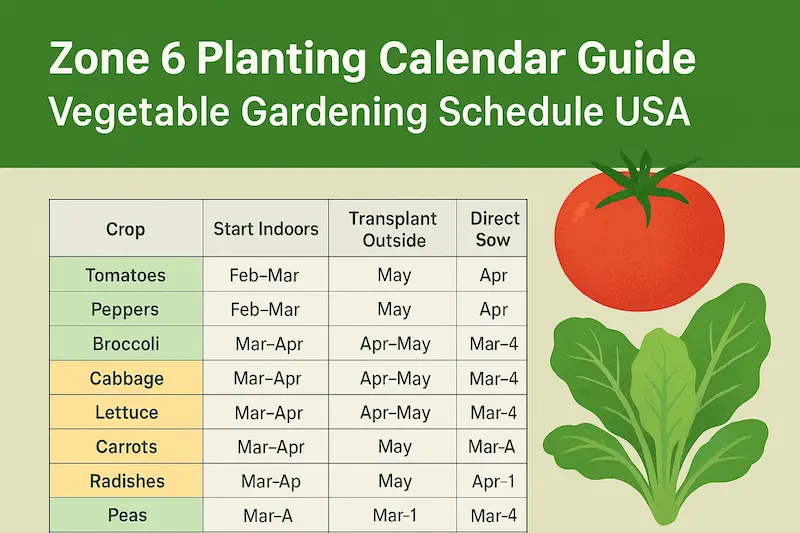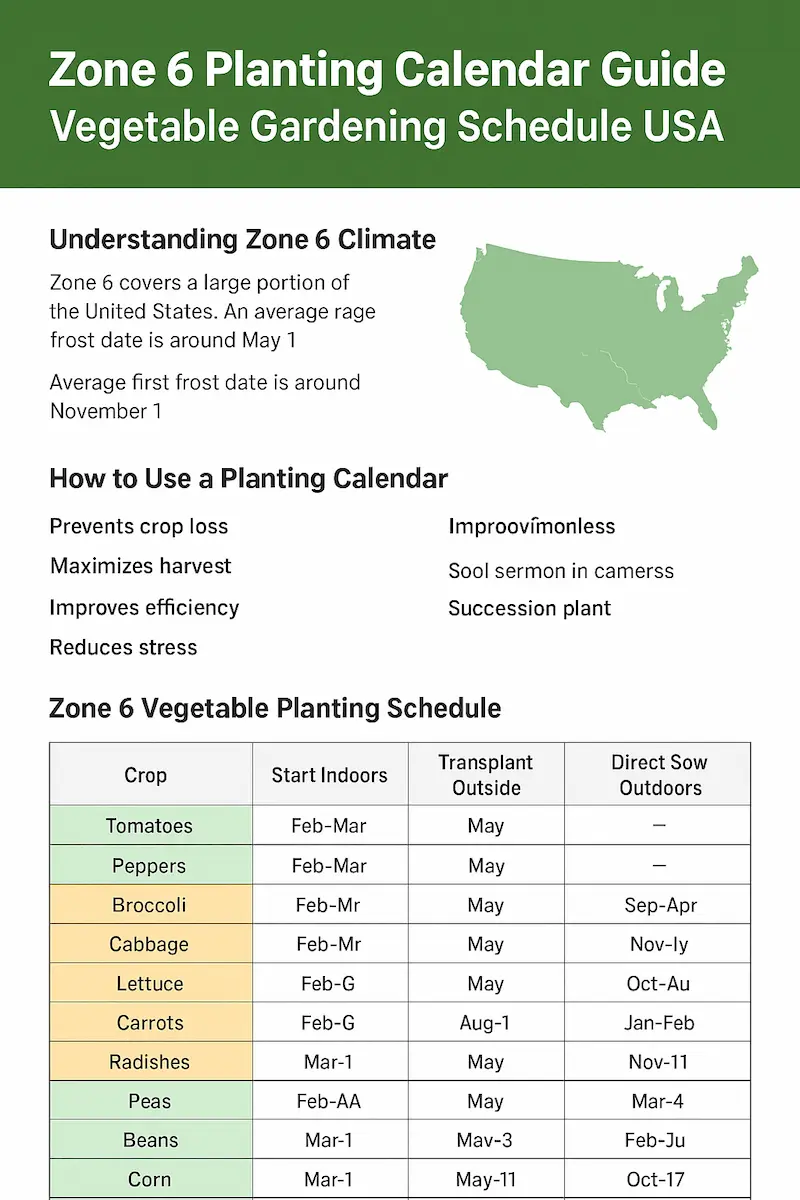Zone 6 Vegetable Planting Calendar Guide
Published: 25 Sep 2025
This guide provides a step-by-step Zone 6 planting calendar, including practical advice on indoor seed starting, transplanting schedules, and direct sowing timelines. Whether you’re growing cool-season crops like lettuce and spinach or warm-season favorites such as tomatoes, peppers, and cucumbers, this calendar will ensure your vegetables thrive.

Understanding Zone 6 Climate
To use a planting calendar effectively, it’s important first to understand the climate conditions of Zone 6. The USDA Hardiness Zone Map divides North America into 13 planting zones, each based on the region’s average minimum winter temperature. Zone 6 covers a large portion of the United States, including parts of the Midwest, Northeast, and some southern states.
Average Frost Dates in Zone 6
- Last spring frost: Around May 1
- First fall frost: Around November 1
These dates may vary slightly depending on your exact location, but they provide a general framework for planning when to start seeds indoors, move seedlings outdoors, and direct sow crops.
Growing Season Length
On average, Zone 6 has a growing season of about 180 days. This relatively long window allows gardeners to cultivate a wide variety of vegetables, from fast-maturing leafy greens to long-season crops like tomatoes, peppers, and pumpkins.
Where Zone 6 Is Located
Zone 6 includes parts of states such as:
- Ohio
- Pennsylvania
- Missouri
- Kansas
- Kentucky
- Virginia
- New Jersey
- Massachusetts
- Portions of neighboring states
If you garden in Zone 6, your climate is characterized by cold winters, mild to warm springs, and hot summers, making it well-suited for both cool-season and warm-season crops.
📌 Key takeaway: By tracking frost dates and understanding the length of your growing season, you can confidently schedule your vegetable planting calendar to achieve multiple harvests in a single year.
Zone 6 Vegetable Planting Schedule
Gardeners in USDA Zone 6 enjoy a long growing season that allows for both cool-weather crops in spring and fall, and warm-weather crops in summer. By following the planting calendar, you can plan multiple harvests throughout the year.

Cool-Season Vegetables (Spring & Fall Planting)
Cool-season vegetables thrive in the mild weather of early spring and fall. These crops can be sown 2–4 weeks before the last spring frost and again in late summer for fall harvest.
Examples of cool-season vegetables in Zone 6:
- Lettuce & Spinach: Direct sow in March–April and again in August–September.
- Carrots & Beets: Plant seeds directly outdoors in March–April and late summer.
- Radishes & Turnips: Fast-growing crops that can be planted multiple times between March and September.
- Broccoli, Cabbage, and Cauliflower: Start seeds indoors in February–March and transplant outdoors in April–May.
- Peas: Plant directly outdoors as soon as the soil is workable, typically in March or April.
- Kale: Hardy enough for both early spring and late summer planting.
👉 Tip: Use row covers in early spring to protect seedlings from unexpected frosts.
Warm-Season Vegetables (Summer Planting)
Warm-season vegetables should only be planted after the last frost date (around May 1 in Zone 6). These crops require warm soil and plenty of sunlight to thrive.
Examples of warm-season vegetables in Zone 6:
- Tomatoes, Peppers, Eggplants: Start indoors in February–March, transplant outdoors in May.
- Beans: Direct sow from May–June for best results.
- Corn: Plant directly outdoors in May–June when the soil is warm.
- Cucumbers & Melons: Start indoors in April or sow outdoors in May–June.
- Squash & Pumpkins: Sow directly outdoors in May–June.
👉 Tip: Use mulch around warm-season crops to retain moisture and prevent weeds during hot summer months.
Fall Planting for Extended Harvest
One of the biggest advantages of Zone 6 gardening is the ability to grow a second crop in late summer and fall. Many cool-weather vegetables perform best when planted as temperatures begin to drop.
Examples of fall crops in Zone 6:
- Spinach & Lettuce: Sow in August–September for a crisp autumn harvest.
- Kale & Turnips: Hardy crops that withstand cooler nights and even light frost.
- Radishes: Quick-growing vegetables perfect for September planting.
- Beets & Carrots: Plant in late summer for harvesting before the first hard frost.
👉 Tip: Consider using cold frames or row covers in the fall to extend the growing season and protect crops from early frosts.
Zone 6 Planting Calendar Table
The planting schedule becomes easier to follow with a visual planting calendar. Below is a color-coded guide showing when to start indoors, transplant outdoors, and direct sow for each major vegetable crop in Zone 6.
🌱 Zone 6 Vegetable Planting Calendar
| Vegetable | Start Indoors | Transplant Outdoors | Direct Sow |
|---|---|---|---|
| Tomatoes | Feb–Mar | May | — |
| Peppers | Feb–Mar | May | — |
| Eggplant | Feb–Mar | May | — |
| Broccoli | Feb–Mar | Apr–May | — |
| Cabbage | Feb–Mar | Apr–May | — |
| Cauliflower | Feb–Mar | Apr–May | — |
| Lettuce | Feb–Mar | Apr–Oct | Mar–Apr, Aug–Sep |
| Spinach | — | — | Mar–Apr, Aug–Sep |
| Kale | — | — | Mar–Apr, Aug |
| Carrots | — | — | Mar–Apr, Aug |
| Radishes | — | — | Mar–May, Aug–Sep |
| Beets | — | — | Mar–Apr, Aug |
| Onions | — | — | Mar–Apr |
| Peas | — | — | Mar–Apr |
| Beans | — | — | May–Jun |
| Corn | — | — | May–Jun |
| Cucumbers | Apr | May | May–Jun |
| Summer Squash | — | — | May–Jun |
| Winter Squash | — | — | May–Jun |
| Pumpkins | — | — | May–Jun |
| Melons | Apr | May | May–Jun |
| Turnips | — | — | Mar–Apr, Aug–Sep |
📌 Key takeaway: By dividing your vegetables into cool-season, warm-season, and fall crops, you can keep your Zone 6 garden productive for up to 180 days each year.
Tips for Successful Gardening in Zone 6
While a planting calendar provides the schedule, the success of your garden also depends on how you prepare and care for your crops throughout the season. Below are essential tips for Zone 6 gardeners to maximize yields and keep vegetables healthy.
Prepare and Improve Your Soil
Healthy soil is the foundation of every productive garden.
- Test your soil: Check pH and nutrient levels before planting. Most vegetables prefer a slightly acidic to neutral pH (6.0–7.0).
- Amend with compost: Add organic matter such as compost or aged manure to improve soil fertility and structure.
- Ensure good drainage: Raised beds or well-prepared garden plots prevent waterlogging and root diseases.
👉 Pro tip: Rotate crops each year to maintain soil health and prevent nutrient depletion.
Watering and Mulching
Consistent watering is critical in Zone 6, especially during hot summer months.
- Water deeply once or twice a week instead of frequent shallow watering.
- Morning watering reduces evaporation and prevents fungal issues.
- Mulch around plants with straw, leaves, or grass clippings to retain soil moisture, regulate temperature, and suppress weeds.
Fertilization and Nutrient Management
Different crops have different nutrient needs.
- Leafy greens (spinach, lettuce, and kale) benefit from nitrogen-rich fertilizers.
- Root crops (carrots, beets, radishes) prefer phosphorus and potassium for root development.
- Fruit-bearing crops (tomatoes, peppers, cucumbers) need balanced fertilization with added calcium to prevent blossom-end rot.
👉 Pro tip: Use slow-release organic fertilizers for long-lasting nutrition.
Pest and Disease Management
Zone 6 gardens attract common pests such as aphids, squash bugs, and cabbage worms.
- Companion planting: Grow marigolds, basil, and nasturtiums to deter harmful insects naturally.
- Inspect plants regularly: Early detection makes pest control more effective.
- Use organic solutions: Neem oil, insecticidal soap, and row covers protect crops without harsh chemicals.
- Practice crop rotation: Reduces the risk of soil-borne diseases.
📌 Key takeaway: With healthy soil, proper watering, smart fertilization, and natural pest control, Zone 6 gardeners can maintain a thriving, productive vegetable garden all season long.
Succession Planting & Year-Round Harvesting
One of the biggest advantages of gardening in Zone 6 is the opportunity to grow multiple crops in the same space during a single season. By practicing succession planting, you can keep your garden producing fresh vegetables from early spring to late fall—and sometimes even into winter with a little protection.
What is Succession Planting?
Succession planting means planting new crops immediately after harvesting earlier ones. Instead of leaving soil bare, you replant with vegetables that thrive in the upcoming season. This technique maximizes garden space and provides a steady supply of produce.
Example successions in Zone 6:
- Spring Radishes → Summer Beans → Fall Spinach
- Lettuce (early spring) → Tomatoes (summer) → Kale (fall)
- Peas (spring) → Cucumbers (summer) → Carrots (fall)
Cool-Season Successions
- Start with radishes, spinach, or peas in early spring.
- Replant with warm-season crops like beans, squash, or peppers in late spring.
- End the year with a fall crop such as turnips, kale, or beets.
Warm-Season Successions
- After harvesting early summer lettuce or beans, plant fast-maturing crops like cucumbers or zucchini.
- Follow with fall carrots or spinach for late-season harvest.
6.4 Extending the Growing Season
Zone 6 has a generous growing window of about 180 days, but with a few simple tools, you can garden even longer:
- Cold frames & row covers: Protect crops from early frosts in fall.
- Greenhouses or hoop houses: Allow you to start seeds earlier in spring and keep hardy greens alive into winter.
- Mulching and cloches: Keep soil warm and protect tender seedlings.
📌 Key takeaway: With succession planting and season-extension techniques, Zone 6 gardeners can enjoy fresh vegetables nearly year-round—turning one harvest into three.
Conclusion
Gardening in USDA Zone 6 is both rewarding and productive, thanks to a long growing season and diverse planting opportunities. By understanding your frost dates, preparing your soil, and following a structured vegetable planting calendar, you can enjoy fresh harvests from early spring until late fall.
Whether you’re sowing cool-season crops like spinach and peas, nurturing warm-season favorites such as tomatoes and peppers, or extending your season with fall crops like kale and carrots, success comes from planning and using your garden space wisely.
Don’t forget to practice succession planting to maximize yields and keep your beds full all season. With proper care—watering, mulching, fertilizing, and pest management—you’ll be rewarded with a garden that thrives year after year.
📌 Final takeaway: The Zone 6 vegetable planting calendar is your roadmap to a thriving garden. Follow it closely, adapt it to your local microclimate, and enjoy the satisfaction of harvesting homegrown produce across three seasons.

- Be Respectful
- Stay Relevant
- Stay Positive
- True Feedback
- Encourage Discussion
- Avoid Spamming
- No Fake News
- Don't Copy-Paste
- No Personal Attacks



- Be Respectful
- Stay Relevant
- Stay Positive
- True Feedback
- Encourage Discussion
- Avoid Spamming
- No Fake News
- Don't Copy-Paste
- No Personal Attacks




